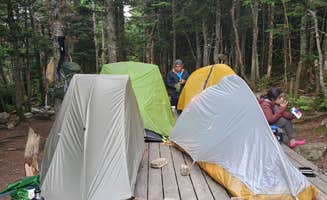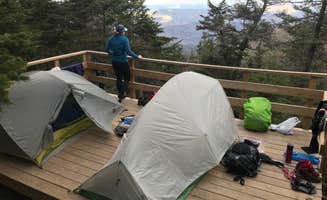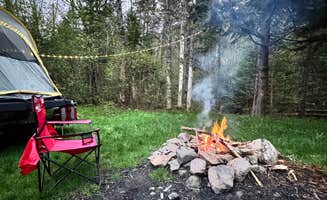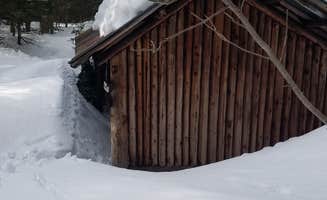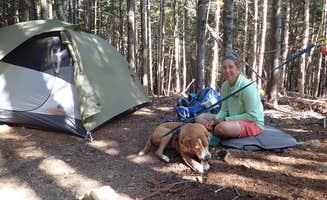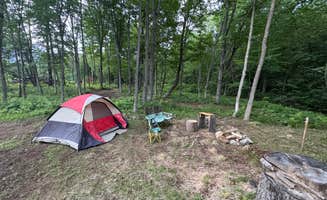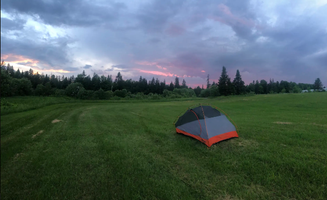Tent camping near Franconia, New Hampshire involves navigating significant elevation changes, with most backcountry sites situated between 3,000-4,500 feet above sea level. Winter conditions can persist into May at higher elevations, with nighttime temperatures dipping below freezing even during summer months. Most established sites require carrying gear over challenging terrain with 1,500-2,500 feet of elevation gain from trailheads.
What to do
Hike to multiple summits: From Guyot Shelter, campers can access several 4,000-footers in a single trip. "We got to the site, claimed our platform and hiked over to West Bond to catch a beautiful sunset," notes Hollie G., who highlights the shelter's strategic position for peak-bagging.
Snowshoe to remote sites: Winter camping provides solitude at most backcountry locations. "Only stayed at the shelter. It was late March with over 4' of snow still on the ground... Super quiet. No human noise. We never saw anyone else. Had to blaze our own trail on Ethan pond trail," reports Ryan M. about his experience at Ethan Pond.
Visit nearby water features: Several backcountry sites offer access to ponds or streams. At Sawyer Pond, campers can enjoy "a pondside campground with a lean-to or tent sites" where "the stars were AMAZING... all around the pond. They took my breath away!" according to Erin H.
What campers like
Isolated backcountry platforms: Tent sites provide varying degrees of seclusion. "Some are very isolated and some with great views," notes Jerome S. about the platforms at Guyot Shelter, adding it's "a very large campground with a large shelter renovated in 2019" and "approx 10 platform sites."
Accessible water sources: Most established sites maintain reliable water access. At Garfield Ridge, Jerome S. mentions a "great water source" that's "0.1 from campsite," though he notes the "pretty steep ascend to get in" requires effort to reach the water.
Bear protection infrastructure: Food storage solutions reduce wildlife encounters. "Bear box located at a communal 'cooking area'," reports Hollie G., while Raj T. notes that Garfield Ridge Campsite offers "Joe boxes for bear protection" alongside other amenities like "cooking and dining area" and "pivy plus ice cold spring water."
What you should know
Platform compatibility: Most sites require specific tent types. "No space for non-free standing tents," warns Sean F. about Guyot Shelter, adding "quite a hike dropping down from the main trail to the campsite, 15-20 min straight up to hike out in the morning."
Weekend crowds: Popular sites fill quickly during peak season. At Liberty Springs Tentsite, which Sean F. calls "a great basecamp for anyone doing the ridge or a pemi loop," he warns it "gets packed on weekends" despite having "a spring for water" and "composting outhouses."
Limited firewood availability: Gathering wood can be challenging at heavily-used sites. At Sawyer Pond, Hunter P. notes "there was very little available firewood near the campsites," despite each site having "a platform to pitch a tent (or 2) on and a fire pit with a grill attachment."
Tips for camping with families
Choose shorter approach trails: Some sites offer beginner-friendly access. Jean C. calls Sawyer Pond "family friendly" with an "easy access" approach, particularly from Sawyer River Road which makes it "my introduction to backpacking more than 40 years ago."
Look for educational opportunities: Natural features provide learning experiences. J.W. recommends Nauman Tentsite, saying "I did it with my 5 year old in tow. It is managed by friendly care takers and has a pit toilet and a bear box for your food."
Consider seasonal timing: Bug activity varies throughout summer. About Sawyer Pond, Jean C. advises "each season offers something different. It's a nice snowshoe hike in winter. I've ice-fished on the pond... Autumn colors across the pond are pretty."
Tips for RVers
Seek dispersed options: Dirt roads provide vehicle-accessible camping. At Cherry Mountain Road Dispersed, Kevin C. notes, "As far as disbursed camping in the national forest, this place is on a decent unpaved road and our campsite was only about 3 miles from the highway."
Check site dimensions: Size varies significantly between pull-offs. Justin P. observes that Cherry Mountain Road has "a string of tent sites on either side of the road" where "a few were small and could just fit a tent and a car, where some offered more space."
Look for sunny locations: Solar power works at select sites. Kevin C. reports "we were able to collect sunlight onto our solar panel from the site" at Cherry Mountain Road, adding the campsite "was open to the sky near the road yet protected from the wind."


